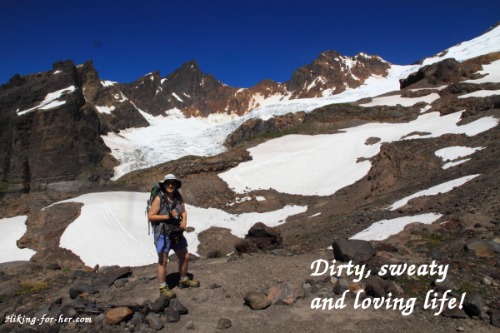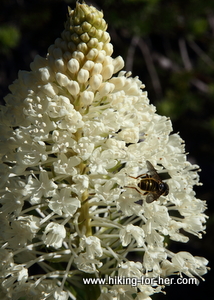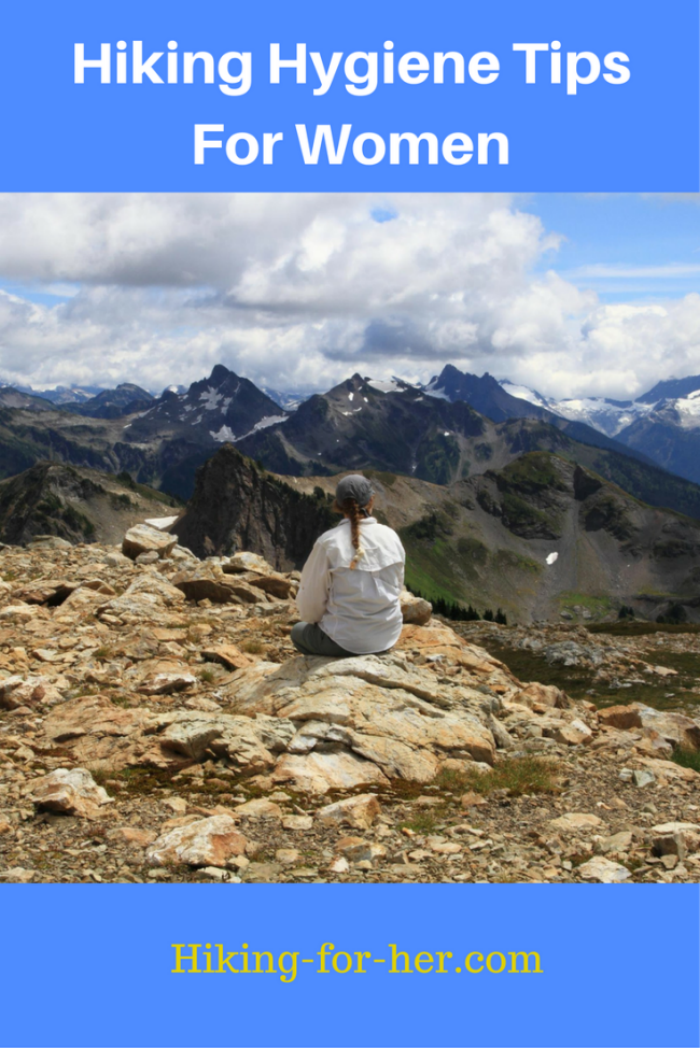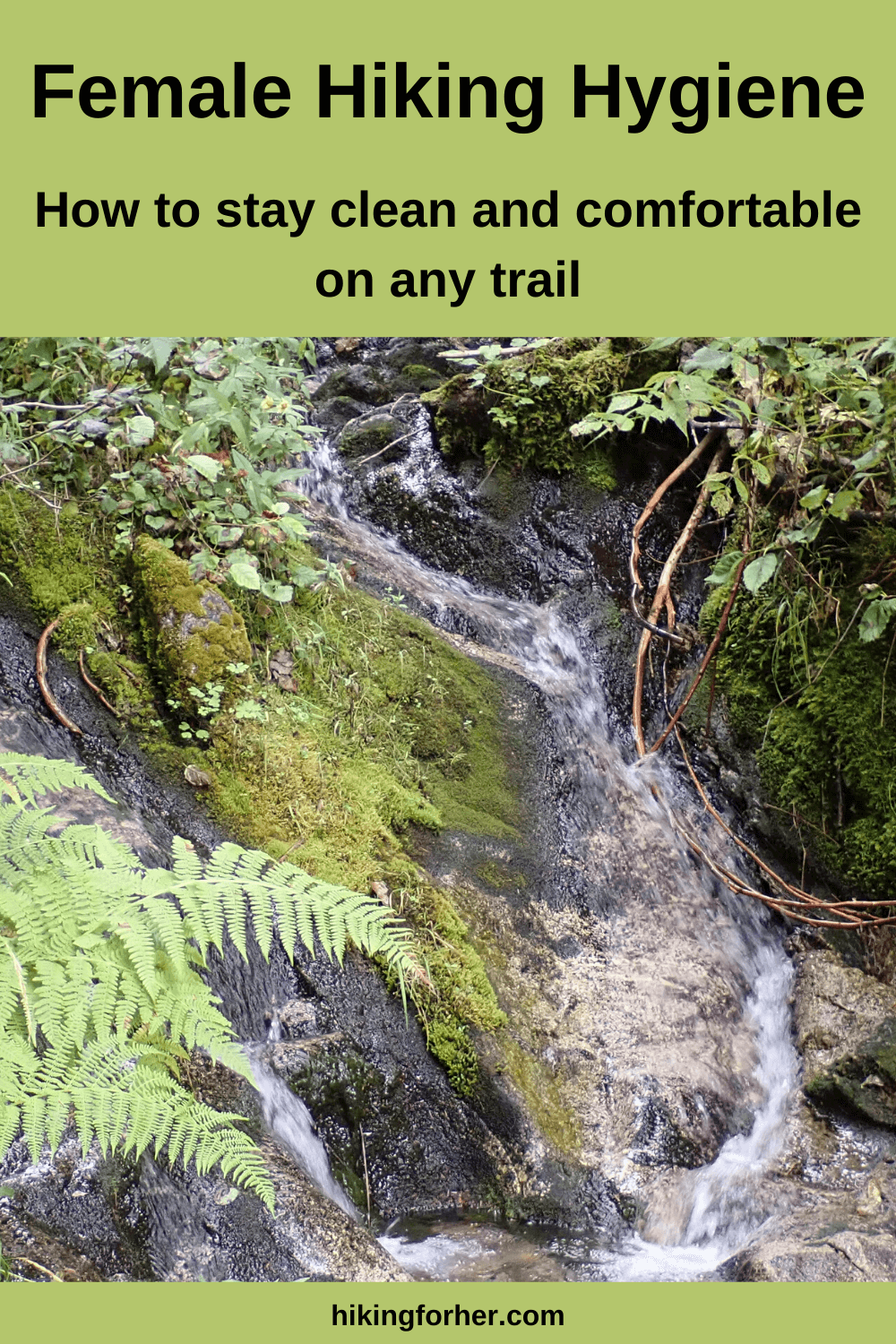
Hiking Hygiene for Women:
Stay Clean And Comfortable On Every Hike
By Diane Spicer
Good hiking hygiene for women on a day hike or backpacking trip means dealing with (gasp!) body fluids.
Yuck, right?
Not so fast, dear hiker!
Let's take a moment to appreciate those body fluids.
Then we can cover some hiking hygiene tips to keep you clean and comfortable while hiking.
Because female hygiene while backpacking, or even on a day hike, should never be left to chance.
Hiking hygiene for women:
SWEAT
SWEAT is the body's mechanism for safely dumping excess heat you generate during exercise.
- It doesn't start to smell until bacteria already living on your body (skin normal flora, filling up all of the cracks and crevices on your epidermis) go to work on it.
And consider this:
- If you didn't have sweat glands, you'd have to pant like a dog to keep your internal body temperature within a safe range during a hot hike.
Sweating hard ("perspiring") on a regular basis during exercise is great for flushing out toxins via the sweat.
And it gets the lymphatic channels moving, too - important for a healthy immune system.
So do you REALLY want to wear an antiperspirant on the trail?
Instead, as a first step in good personal hygiene while backpacking or day hiking, wear loose fitted moisture wicking shirts with great ventilation.
Tank tops need straps that are wide enough to cushion your skin from your backpack straps.
Also look for an antimicrobial component built into the fabric, if you're afraid of offensive odors.
- Moisture control is a hallmark of Ex Officio hiking clothing, so be sure to examine all of your options.

Your skin really takes a beating from salty sweat and other trail hazards.
- These skin care tips for the trail will keep your skin in top condition.
More body fluids:
URINE
Urine is the way you let go of the substances your body doesn't need.
So it's a good thing, right?
Absolutely!
Every time you urinate (pee), you are saying good-bye to the end products of biochemical reactions your cells used to:
- produce energy for your hike,
- rebuild from injury or stress, and to
- replenish themselves.
Urine comes from a sterile environment (your kidneys and bladder), and should not have an offensive odor.
If it does, you might have a urinary tract infection.
Keep on eye on these problems:
- burning sensations during urination,
- fever and/or chills,
- dull ache in your upper back,
- cloudy, stinky urine ...
definitely symptoms you want to bring to a health care provider as soon as possible after your hike.
Use the color of your urine for immediate feedback about how hydrated you are (or aren't!).
- Pale yellow pee in large amounts: you have plenty of water in your bloodstream.
- The darker the color, the more urgently you need to drink pure, cool water.
Allow me give you some resources that can make this particular "hiking hygiene for women potential nightmare" [a.k.a."pit stops"] easier to handle.
Ready? Here we go...
Pee like the guys
You could stand up when you pee, using a device designed to let you have the freedom of male anatomy.
The upsides?
- No squatting behind a rock (if you're lucky enough to find one large enough).
- No pulling down your drawers in less than ideal conditions (cold, windy, scratchy brush, rocky terrain with no handy coverage).
Here are 2 popular choices competing for the best female urination device:
Hiking hygiene for women: carry a female hiker hygiene kit
Rather than trying to keep bulky toilet paper dry and clean, I always carry travel sized packs of disposable wipes in my "hygiene kit", along with a plastic bag to receive the used ones.
I really love one particular brand because it smells great and has just the right amount of moisture to clean me up without lots of chemicals (such as nasty parabens) contacting my skin.
And you can use these wipes on your face, too! Sweat and urine issues, solved in one step!
 Keep the wilderness pristine with good hygiene habits
Keep the wilderness pristine with good hygiene habitsTrail tip
To be a responsible hiker, make it a habit to:
- pack out used wipes or toilet paper
- pee way off the trail so wildlife isn't tempted to get ornery with passing hikers (goats & chipmunks love to lick the salt in your urine off the rocks)
- avoid peeing directly on plants (the salts will burn their leaves)
That's part of Leave No Trace hiking.
Read more about socially responsible hiking.
Use a pee rag: a brilliant hiking hygiene for women solution
One more idea:
Forego the toilet paper and wipes altogether by using a pee rag!
- This idea for solving a universal hiking hygiene for women problem is not for everyone.
- Guys are totally grossed out by it, which could be useful in certain situations.
- Be sure the rag dries thoroughly in sunlight, and don't use it any other way.
- A dedicated rag ;)
A small microfiber towel like this one can also be ideal because it dries quickly and can be rinsed out and hung to dry overnight inside your tent.
Or use a dedicated cloth from this women led company named Kula. Lots of fun prints and colors!
Pee bottle for backpackers
Why answer nature's call at 1A outside of the tent?
Avoid worrying about how to squat and pee without peeing on yourself, in the dark, with hordes of mosquitoes as your only companions.
If you have a wide mouth reusable plastic bottle beside your sleeping bag, and you have the luxury of privacy or an understanding tent mate, drop your drawers, squat and collect your urine.
No cold, wet, dirty feet.
No zipping, unzipping, layering and unlayering.
A lightweight indestructible container like this Nalgene wide mouth bottle is suitable.
Revisit the info on female urination devices above, because you'll need one to direct the flow of your urine into your bottle, rather than into your sleeping bag.
- Just sayin'
Tip: Use an indelible marker like a Sharpie to label it as your pee bottle, rather than your water bottle.
You knew this was coming:
BLOOD
Blood: the body's river of life, delivers oxygen to trillions of cells.
It carries away waste products, too:
- carbon dioxide to the lungs as you exhale,
- toxic nitrogen compounds to the kidney when you urinate (see above),
- toxins in your food or medications, to be dealt with by the liver,
- infectious organisms to the lymph nodes...
Wow!
Hopefully, you're planning to keep your blood in your body (mosquitoes might steal a bit unless you're using repellents or bug nets).
Menstrual blood & hikers
But then there's the monthly menstrual cycle blood to think about if you're in a certain age bracket.
Menstrual blood is definitely on the list as a hiking hygiene for women major concern!
This particular body fluid is released in relatively small amounts (compared with your total blood volume) when chemical messengers (hormones) tell the cells lining the uterus to slough off because there's no fertilized egg this month.
And away it goes, out of the body and into whatever receptacle you've chosen: tampon, sanitary napkin, etc.
Menstrual blood should not have an offensive odor unless there's an infection in the reproductive tract.
I am not saying it will be odorless, just that you shouldn't smell ammonia or other strong odors.
Your monthly cycle ties your body to the phases of the moon, to fertility, to your feelings about your body - and most importantly from a biology standpoint, this cycle guarantees the continuation of the human species.
All good reasons to honor the cycle, not dread it.
But realistically, you need to plan your hiking around your monthly flow.
Don't avoid hiking, but be sure to have the supplies you need and use proper disposal methods.
Hiking hygiene for women comes with the responsibility to make sure no one coming behind you on the trail knows that you've had to make that kind of pit stop.
Try an internal cup
Here's one approach to skipping the whole tampons/sanitary napkins supply issue: use an internal cup to catch your menstrual flow while backpacking.
The Diva Cup gets high marks from female hikers.
Be sure your hands are really, really clean when you insert and remove this cup.
- Hand sanitizer is okay, but nothing beats soap and water for removing the most grime.
- Clean the cup and dispose of the menstrual fluids away from water sources or areas where other hikers might rest or camp.
And here's another important tip:
Using paper products during your period?
If you use paper products like tampons and sanitary napkins, you're going to have to pack out the used ones.
Be sure you've counted out, and packed, how many of these you'll be needing for your day hike or a multi day backpacking trip.
- Then add a few extras, which can be used as fire starters or first aid supplies in emergencies.
Seal them in plastic bags, and double bag them because if they get wet or dirty, they're un-useable.
Here's a new twist on carrying out used hygiene products: a self sealing biodegradable pouch that eliminates mess and odors.
There are different sizes for tampons and pads.
Clever idea, no?
Are menstrual odors going to attract bears?
Women sometimes wonder about the odor of menstrual blood attracting bears or other predators.
Any truth to this worry about hiking hygiene for women?
The Journal of Wildlife Management published some research results in 1991(a bit dated, but worthy of reading).
To bottom line it for you, NO - bears seem to prefer your food to your used "feminine hygiene" products. So on a hiking trip, hang your food properly, to avoid bear visitors.
You can use a stuff sack, or a bear bag, just don't ever bring the bag into your tent once it's gotten food odors embedded in it.
Or skip the hanging routine, and use a bear canister - to safely stow your food, not the bear!
- Be sure you put your camp kitchen and the canister far, far away from your tent.
Need some more tips on how to handle the "monthly issues" while on the trail, as well as other female hiker hygiene tips?
- Hop on over here.
An aside I can't resist
I always giggle when I take a trip down "that" aisle at the store and see "feminine protection" plastered on the boxes.
I sort of expect a knight in shining armor to charge out on his horse when I open the flap.
Sadly, it hasn't happened yet...
Blood, sweat... What's next?
TEARS!
If you understand that musical reference, you're crying because your elderly knees hurt on the trail.
Other possibilities:
- You are overcome with emotion during a spectacular sunset.
- Maybe you are suffering from blisters.
- You just spotted a deceased (as in stinky) marmot after you stepped on it.
- You are reacting to your discovery of a new species of stinging insect (congrats!).
- Or you desperately need these tips for improving your trail techniques.
Wash out your sore eyes
Clearly, these hiking hygiene for women tips are not uppermost in your mind as you weep.
But once you've recovered your equilibrium, wash those sore eyes and trail dust out of your eyes.
They will feel so much better!
After a few almost-serious eye events, I'm never without eye drops in my first aid kit.
I dislike the kind that promise to make the whites of the eye white again, because they do so by shrinking the diameter of blood vessels to the eye. I want blood flowing to my eyes!
Here's what I use instead: individual packets of preservative free eye drops.
Adding these drops to my eyes doesn't sting, and it soothes my irritated eyeballs quickly so I can get back to hiking, or resting.
There are no chemicals, odors or staining associated with these handy little droppers.
I predict that you'll be grossed out by the amount of trail dirt floating around on your eyeballs and lids.
Be sure you toss the clever little plastic applicators into your trash bag and pack them out for proper disposal.
- Being responsible about trash is a basic tenet of hiking hygiene for women hikers, right?
- Leave No Trace hiking principles are the only way to go.
Hey! What's the scoop on POOP?
Answered your own question right there, you clever hiker.
Carry an unbendable trowel like this one.
- Use it in a scooping fashion to dig a shallow hole before crouching over it to eliminate your solid waste.
- Then use it to cover up your poop.
Sounds like something you could never, ever do?
Practice, my dear.
Because NOT eliminating is not an option in the hiking hygiene for women rule book.
- Here's a book that can help you, with a title that should get your attention.
Admittedly, solid waste hiking hygiene for women is not much fun. But it's manageable!
Female backpacking hygiene kit
By now you realize that hiking hygiene for women backpackers - or even on a day hike that lasts single digit hours - is a blend of personal preferences and standard tried and true items.
Every one of us intrepid female hikers works up a sweat on the trail, but not all of us have to deal with menstrual flow on a hike.
- So be sure to customize your hiking hygiene kit for not only the season, but the day of the month.
- Make some decisions about which camping hygiene essentials you want to bring along on a backpacking trip.
- And restock your kit as soon as you get home, rather than risk going without a hygiene product that you really need on the trail.
- Emptying your used supplies as soon as you get home is also a way to be nice to yourself.
Appreciate your body fluids!
 Hiking hygiene for women: have a great relationship with your body, just like this bee and bear grass!
Hiking hygiene for women: have a great relationship with your body, just like this bee and bear grass!Your strong, healthy hiker body is awash in fluids, and for good reasons.
That's why these tips on hiking hygiene for women celebrate your fluids!
You can support your fluids with good hydration, great nutrition, appropriately timed "pit stops", and a peaceful mental attitude toward "that time of the month".
Work with your body, not against it,
to be the strongest, juiciest hiker you can be.
Hiking hygiene for women hikers needs it own day to celebrate our juiciness!
Body Fluids Appreciation Day has a nice ring to it, don't you think?
Home page > Best Hiking Tips >
Hiking Hygiene for Women
|
I get emails all the time about what I wear, eat, carry and love to use on the trail. That's
why I provide affiliate links to you: the best gear that I use myself and have seen used by other hikers is instantly
available for your consideration, and the gear company sends a few
pennies per dollar to this reader-supported hiking website. There is no added cost to you! Everyone ends up a winner: Great gear for you, strong gear companies, and more free hiking tips for everyone. Thanks very much for your support. It's warmly and sincerely appreciated. It also helps send these hiking tips to all your virtual trail buddies around the globe. |
 |



